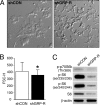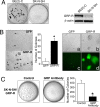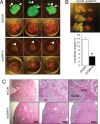Gastrin-releasing peptide receptor silencing suppresses the tumorigenesis and metastatic potential of neuroblastoma
- PMID: 18753628
- PMCID: PMC2529092
- DOI: 10.1073/pnas.0711861105
Gastrin-releasing peptide receptor silencing suppresses the tumorigenesis and metastatic potential of neuroblastoma
Abstract
Neuroblastoma accounts for nearly 15% of all pediatric cancer-related deaths. We have previously shown that gastrin-releasing peptide (GRP) stimulates neuroblastoma growth, and that its cell surface receptor, GRP-R, is overexpressed in advanced-stage human neuroblastomas; however, the effects of GRP/GRP-R on tumorigenesis and metastasis in vivo are not clearly elucidated. In the present study, we found that GRP-R knockdown in the aggressive cell line BE(2)-C induced cell morphology changes, reduced cell size, decreased cell proliferation, and inhibited DNA synthesis, corresponding to cell cycle arrest at G(2)/M phase. Activated Akt, a crucial regulator of cell survival and metastasis, was down-regulated by GRP-R silencing. In addition, expression of p-p70S6K and its downstream target molecule S6, key regulators of protein synthesis and cell metabolism, were also significantly decreased by GRP-R silencing. GRP-R knockdown also up-regulated the expression of tumor suppressor PTEN, the inhibitor of the PI3K/Akt pathway. Furthermore, silencing GRP-R as well as GRP in BE(2)-C cells suppressed anchorage-independent growth in vitro. Conversely, overexpression of GRP-R in less aggressive SK-N-SH neuroblastoma cells resulted in soft agar colony formation, which was inhibited by a GRP-blocking antibody. Moreover, GRP-R deficiency significantly delayed tumor growth and diminished liver metastases in vivo. Our findings demonstrate that GRP and GRP-R have important oncogenic properties beyond their established mitogenic functions. Therefore, GRP-R may be an ideal therapeutic target for the treatment of aggressive neuroblastomas.
Conflict of interest statement
The authors declare no conflict of interest.
Figures






References
-
- Kushner BH, et al. Reduction from seven to five cycles of intensive induction chemotherapy in children with high-risk neuroblastoma. J Clin Oncol. 2004;22:4888–4892. - PubMed
-
- Gustafson WC, De Berry BB, Evers BM, Chung DH. Role of gastrointestinal hormones in neuroblastoma. World J Surg. 2005;29:281–286. - PubMed
-
- Moody TW, Carney DN, Cuttitta F, Quattrocchi K, Minna JD. High affinity receptors for bombesin/GRP-like peptides on human small cell lung cancer. Life Sci. 1985;37:105–113. - PubMed
-
- Markwalder R, Reubi JC. Gastrin-releasing peptide receptors in the human prostate: relation to neoplastic transformation. Cancer Res. 1999;59:1152–1159. - PubMed
Publication types
MeSH terms
Substances
Grants and funding
LinkOut - more resources
Full Text Sources
Medical
Research Materials

